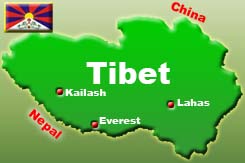China to build homes for 500,000 Tibetan herders
 Beijing - China plans to build homes in towns and villages for nearly 500,000 members of Tibetan herding families in the south-western province of Sichuan, state media said on Saturday.
Beijing - China plans to build homes in towns and villages for nearly 500,000 members of Tibetan herding families in the south-western province of Sichuan, state media said on Saturday.
The Sichuan provincial government said it will help 470,000 Tibetans to "settle down in permanent brick houses" in the next four years, the official Xinhua news agency reported.
The province will invest some 5 billion yuan (735 million dollars) in the project, which will include new primary schools, clinics, offices and "other public service infrastructure", the agency said.
"Local authorities will also invite industrial businesses to design and manufacture special tents and other living products ... in a bid to provide a 'modern life' in their nomadic life," it quoted the provincial government as saying after a meeting on Friday.
The plan is aimed at having all 533,000 Tibetan herders in Sichuan living in permanent housing, according to statistics given by the agency.
About 219,000 herders in Sichuan have no fixed residence and 254,000 are living in "shanty houses," it said.
The report did not say if the Tibetan families would face compulsory resettlement.
It said similar projects were carried out for Tibetan nomads in the neighbouring Tibet Autonomous Region and Qinghai and Gansu provinces.
China is home to about 6 million Tibetans, including some 2.5 million in the Autonomous Region.
China's ruling Communist Party regularly trumpets its level of investment in Tibetan areas and highlights economic and social progress over the last 50 years.
But critics among exiled Tibetans and Western rights activists say the development of Tibetan areas threatens traditional Tibetan culture and has allowed an influx of Han Chinese migrants.
Authorities in Lhasa, the capital of the Autonomous Region, last November began building a huge new district to help the city accommodate an influx of tourists and migrants.
The city plans to finish the Liuwu New District by 2009 to house 110,000 people on undeveloped land land south of the Lhasa river to "divert the city's growing population and protect cultural relics," state media said.
Lhasa and other cities on the Tibetan plateau are sharply divided into areas occupied by Tibetans and Han Chinese or Muslim Hui migrants.
Pro-independence demonstrations and unrest began in Lhasa and other Tibetan areas on March 10, the 49th anniversary of a failed Tibetan uprising against Chinese rule.
The Chinese government said 19 people were killed in rioting from March 14 in Lhasa but the Tibetan government-in-exile said about 140 people were killed, most of them Tibetans shot by Chinese police.
Protests erupted in dozens of other Tibetan areas of China.
Last year the Dalai Lama, the exiled Buddhist leader of Tibet, said a new railway to Lhasa had allowed the start of a "second invasion of Tibet" by Chinese migrants since
2006.
The Dalai Lama fled to India in 1959 after an abortive uprising against the occupation of Tibet by Chinese troops since 1951. (dpa)